Yeast Strain Selection to Produce Sulfur Dioxide-Free Merlot Wine (2017)
Katell Griaud and Cassandra Derby
Slater Run Vineyards
Summary and Introduction
This study examines the efficacy of non-Saccharomyces yeast selection to produce wines without the use of sulfur dioxide. Merlot grapes were harvested on September 28 and stored overnight at 45°F. The next day fruit was destemmed, sorted, and crushed into two separate bins (0.5 tons per treatment). One bin received 6g/hL sulfur dioxide (control), and the other received 5g/hL Primaflora VR Bio (AEB) as a sulfur dioxide replacement (no sulfur dioxide treatment). Both bins received a two day cold soak (one punchdown per day, with dry ice additions), and then the control bin received 15g/hL FX10, and the treatment received 15g/hL FX10. At this point the bins were moved out of the cold room in order to warm up. Punchdowns were twice per day until fermentation became vigorous (October 6), which then received 3 punchdowns per day. Fermentation lasted for 8 days, after which the wine was drained off the skins and put into stainless steel tanks for aging (only free run was used). On November 30, wines were filtered with K250/EK filters and sterile filtered (0.45 micron) and bottled on December 7. At bottling, the control received 1g/hL sulfur dioxide. The wine without sulfur dioxide had slightly less alcohol and lactic acid, and slightly increased volatile acidity. It also had less color and had a slightly longer lag phase in fermentation. The no sulfur dioxide wine seemed to have more yeasts throughout its life except for Hanseniaspora, relative to the control. Both fermentations had similar bacterial counts. Overall, judges were more or less able to correctly distinguish the wines made with and without sulfur dioxide, although in one tasting this was statistically significant and at the other it was not. Judges tended to prefer the wine made without sulfur dioxide. The no sulfur wine may have had higher Fruit Intensity, higher Overall Aromatic Intensity, and higher perceived Acidity relative to the wine made with sulfur dioxide.
Results and Discussion
The wine without sulfur dioxide had slightly less alcohol and lactic acid, and slightly increased volatile acidity. It also had less color and had a slightly longer lag phase in fermentation. The no sulfur dioxide wine seemed to have more yeasts throughout its life except for Hanseniaspora, relative to the control. Both fermentations had similar bacterial counts.





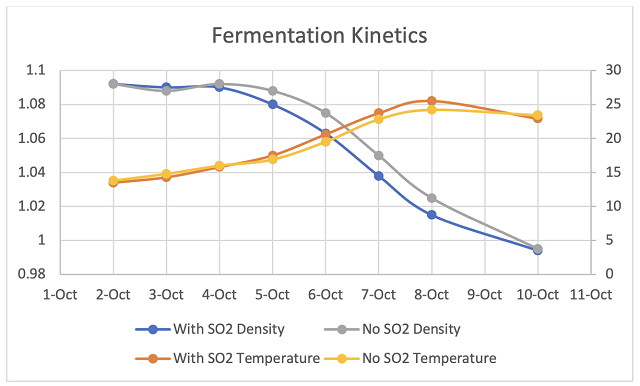
For the triangle test on February 7, of 25 people who answered, 12 people chose the correct wine (48%), suggesting the wines were not significantly different. In general, people who answered correctly preferred the no sulfur dioxide wine to the control, although this was a weak preference. For the descriptive analysis, there were no strong trends for the descriptors used in this study. There was a slight tendency for the no sulfur dioxide treatment to have higher Overall Aromatic Intensity and Fruit Intensity.
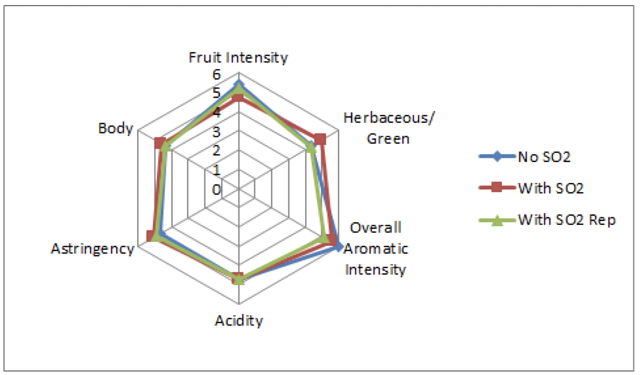
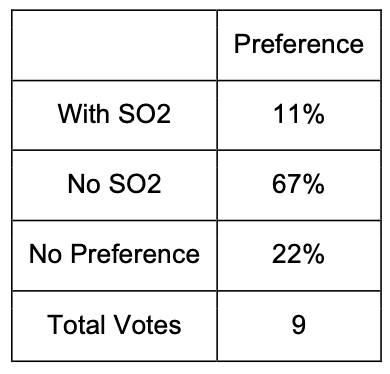
For the triangle test on February 28, of 29 judges who answered, 20 identified the correct wine (69%), suggesting that the wines were significantly different (p<0.001). Of those who answered correctly, the wine was voted to have an average degree of difference of 5.3, suggesting that the wines were moderately different. There was a strong preference for the wine made with no sulfur dioxide. For the descriptive analysis, there were no strong trends for the descriptors used in this study. There was a slight tendency for the no sulfur wines to have higher Acidity and lower Astringency.
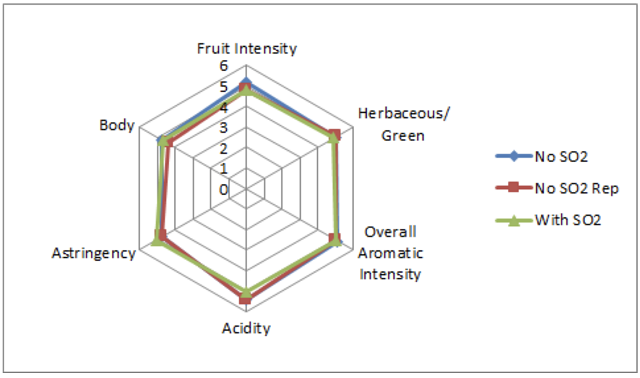
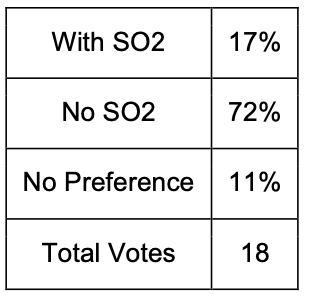
Overall, judges were more or less able to correctly distinguish the wines made with and without sulfur dioxide, although in one tasting this was statistically significant and at the other it was not. Judges tended to prefer the wine made without sulfur dioxide. The no sulfur wine may have had higher Fruit Intensity, higher Overall Aromatic Intensity, and higher perceived Acidity relative to the wine made with sulfur dioxide. More work is needed on different no sulfur winemaking techniques, including non-Saccharomyces yeast-based protection of musts. Additionally, the evolution of these wines during aging should be monitored as well.
Methods
Merlot grapes were harvested from Breaux vineyards on September 28, 2018 and stored overnight at 45°F. The next day fruit was destemmed, sorted (vibrating sorting table), and crushed into two separate bins (0.5 tons per treatment). Both bins received 2g/L untoasted oak chips. One bin 6g/hL sulfur dioxide (control), and the other received 5g/hL Primaflora VR Bio (AEB) as a sulfur dioxide replacement (no sulfur dioxide treatment). At this time juice samples were frozen for later microbial analysis. Both bins received a two day cold soak (one punchdown per day, with dry ice additions), and on October 2 15g/hL Thiazote and 30g/hL Superstart Rouge were added to each bin. The control bin received 15g/hL FX10 were added to each bin, and the treatment received 15g/hL FX10. At this point the bins were moved out of the cold room in order to warm up and a cold soak samples was taken for the WRE. Punchdowns were twice per day with carbon dioxide added on top until fermentation became vigorous (10/6), which then received 3 punchdowns per day. On October 8, both fermentations received 15g/hL Thiazote. Fermentation lasted for 8 days, after which (October 10) the wine was drained off the skins and put into stainless steel tanks for aging (only free run was used). Wines were racked on October 31, after completion of malolactic conversion. On November 7, both wines received 6g/hL Chitosan and were racked off the lees on November 14. On November 30, wines were filtered with K250/EK filters and sterile filtered (0.45 micron) and bottled on December 7. At bottling, the control received 1g/hL sulfur dioxide. 16 cases of wine per treatment were created in total for this project.
These wines were tasted on February 7 and February 28, 2018. For the triangle test, descriptive analysis, and preference analysis for the February 7 tasting, anybody who did not answer the form were removed from consideration for both triangle, degree of difference, and preference. Additionally, anybody who answered the triangle test incorrectly were removed from consideration for degree of difference and preference. Additionally, any data points for preference which did not make sense (such as a person ranking a wine and its replicate at most and least preferred, when they correctly guessed the odd wine) were removed.
In order to balance the data set to perform statistical analysis for descriptive analysis on the February 7 tasting, any judge who had not fully completed the descriptive analysis ratings were removed. In order to then make the number of judges between groups equivalent, one judge from group 3 was transferred to group 1, and another judge from groups 2 and 3 were eliminated. This resulted in a final data set of 3 groups, each with 7 judges (considered as replications within groups, and groups were considered as assessors). Data was analyzed using Panel Check V1.4.2. Because this is not a truly statistical set-up, any results which are found to be statistically significant (p<0.05) will be denoted as a “strong trend” or a “strong tendency,” as opposed to general trends or tendencies. The statistical significance here will ignore any other significant effects or interactions which may confound the results (such as a statistically significant interaction of Judge x Wine confounding a significant result from Wine alone). The descriptors used in this study were Fruit Intensity, Herbaceous/Green, Overall Aromatic Intensity, Acidity, Astringency, and Body.
The same procedures for data analysis were used on the February 28 tasting. For the descriptive analysis in this tasting, one judge was transferred from group 2 to group 1, and another judge was eliminated from group 2 so that each group had 7 judges, for a total of 21 judges.
